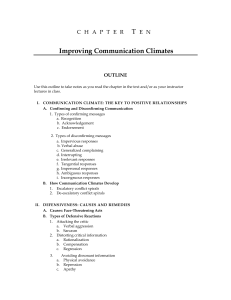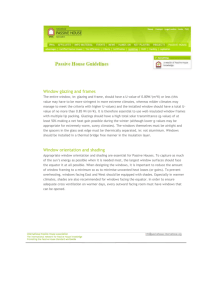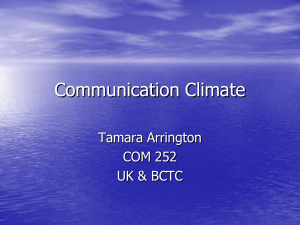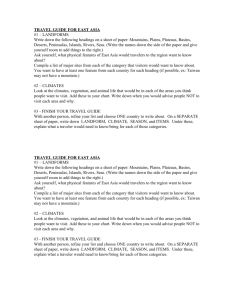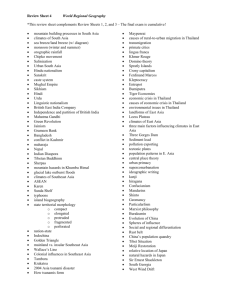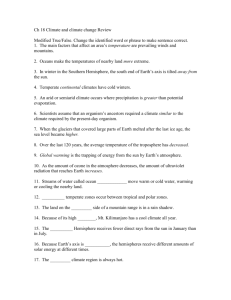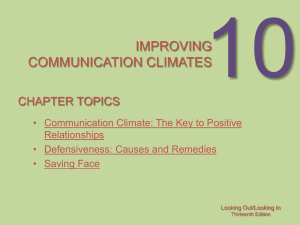IMPROVING COMMUNICATION CLIMATES
advertisement
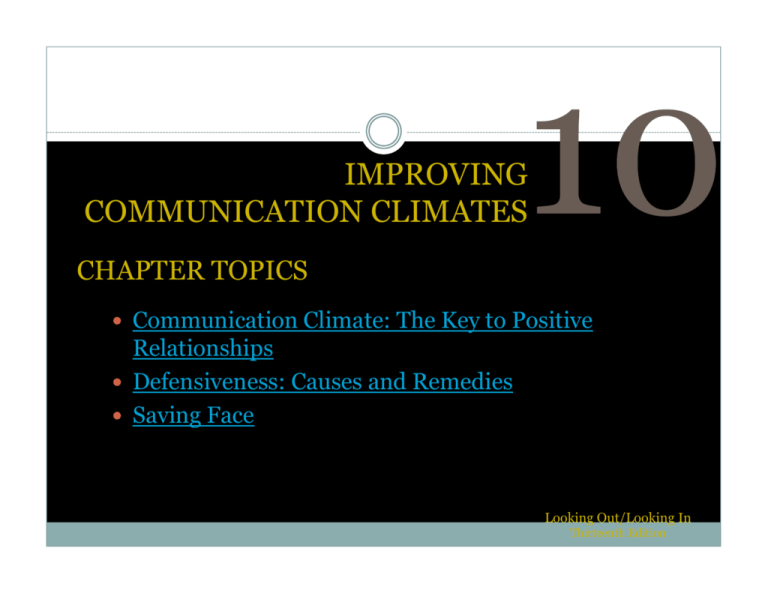
IMPROVING COMMUNICATION CLIMATES CHAPTER TOPICS Communication Climate: The Key to Positive Relationships Defensiveness: Causes and Remedies Saving Face Looking Out/Looking In Thirteenth Edition Communication Climate Communication Climate Refers to the emotional tone of a relationship Levels of Message Confirmation Confirming Communication Describes messages that convey valuing Disconfirming Communication Describes messages that show a lack of regard IMPROVING COMMUNICATION CLIMATES 2 Communication Climate Disconfirming Messages Impervious Responses Interrupting Doesn’t acknowledge the other person’s message Beginning to speak before the other person has finished Irrelevant Responses A comment unrelated to what the other person has just said IMPROVING COMMUNICATION CLIMATES 3 Communication Climate Disconfirming Messages Tangential Responses Impersonal Responses The speaker uses the other’s remarks as a starting point to shift the conversation Loaded with clichés and other statements that never truly respond to the speaker Ambiguous Responses Contain messages with more than one meaning, leaving the other party unsure IMPROVING COMMUNICATION CLIMATES 4 Communication Climate Disconfirming Messages Incongruous Responses Contains two messages that seem to deny or contradict each other. “Darling, I love you.” “I love you, too.” (Said in a monotone while watching TV) Disagreeing Messages Aggressiveness Complaining Argumentativeness IMPROVING COMMUNICATION CLIMATES 5 Communication Climate Confirming Messages Recognition Acknowledgement Recognize the other person Includes asking questions, paraphrasing and reflecting Endorsement The most obvious form of endorsement is agreeing IMPROVING COMMUNICATION CLIMATES 6 Communication Climate How Communication Climates Develop When two people start to communicate, a relational climate begins to develop Verbal and nonverbal communication can be climate-shaping After a climate is formed, it can take on a life of its own and become a self-perpetuating spiral IMPROVING COMMUNICATION CLIMATES 7 Communication Climate Spirals A reciprocating communication pattern in which each person’s message reinforces the others IMPROVING COMMUNICATION CLIMATES 8 Communication Climate Spirals Escalatory conflict spirals A: (Mildly irritated) “Where were you? I thought we agreed to meet here a half-hour ago.” B: (Defensively) “I’m sorry. I got hung up at the library. I don’t have as much free time as you do.” A: “I wasn’t blaming you, so don’t get so touchy.” B: “Who’s getting touchy? I just made a simple comment.” IMPROVING COMMUNICATION CLIMATES 9 Communication Climate Spirals De-escalatory conflict spirals Rather than fighting, parties slowly lessen their dependence on each other, withdraw and become less invested in the relationship Rarely go on indefinitely Most relationships pass through cycles of progression and regression IMPROVING COMMUNICATION CLIMATES 10 Defensiveness: Causes and Remedies Face-Threatening Acts Messages that seem to challenge the image we want to project Defensiveness becomes the process of protecting our presenting self, our face Preventing Defensiveness in Others Jack Gibb isolated six types of defense-arousing communication and six contrasting behaviors IMPROVING COMMUNICATION CLIMATES 11 Defensiveness: Causes and Remedies The Gibb Categories of Defensive and Supportive Behaviors Defensive Behaviors Supportive Behaviors 1. Evaluation 1. Description 2. Control 2. Problem Orientation 3. Strategy 3. Spontaneity 4. Neutrality 4. Empathy 5. Superiority 5. Equality 6. Certainty 6. Provisionalism Table 10.3 Page 350 IMPROVING COMMUNICATION CLIMATES 12 Defensiveness: Causes and Remedies Gibb Categories Evaluation versus Description Evaluation: “You don’t know what you’re talking about!” Description: “I don’t understand how you came up with that idea.” Evaluation: “This place is a mess!” Description: “When you don’t clean up, I have to either do it, or live with your mess. That’s why I’m mad!” IMPROVING COMMUNICATION CLIMATES 13 Defensiveness: Causes and Remedies Gibb Categories Control versus Problem Orientation Controlling: “You need to stay off the phone for the next two hours.” Problem orientation: “I’m expecting some important calls. Can we work out a way to keep the line open?” Controlling: “There’s only one way to handle this problem.” Problem orientation: “Lets work out a solution we can both live with.” IMPROVING COMMUNICATION CLIMATES 14 Defensiveness: Causes and Remedies Gibb Categories Strategy versus Spontaneity Strategy: What are you doing Friday after work?” Spontaneity: “I have a piano I need to move Friday after work. Can you give me a hand?” Strategy: “Tom and Judy go out to dinner every week.” Spontaneity: “I’d like to go out to dinner more often.” IMPROVING COMMUNICATION CLIMATES 15 Defensiveness: Causes and Remedies Gibb Categories Neutrality versus Empathy Neutral: “That’s what happens when you don’t plan properly.” Empathic: “Ouch – looks like this didn’t turn out the way you expected.” Neutral: “Sometimes things just don’t work out. That’s the way it goes.” Empathic: “I know you put a lot of time and effort into this project.” IMPROVING COMMUNICATION CLIMATES 16 Defensiveness: Causes and Remedies Gibb Categories Superiority versus Equality Superior: “You don’t know what you’re talking about.” Equal: “I see it a different way.” Superior: “No, that’s not the right way to do it!” Equal: “If you want, I can show you a way that has worked for me.” IMPROVING COMMUNICATION CLIMATES 17 Defensiveness: Causes and Remedies Gibb Categories Certainty versus Provisionalism Certain: “That will never work!” Provisional: “I think you’ll run into problems with that approach.” Certain: “You don’t know what you’re talking about!” Provisional: “I’ve never heard anything like that before. Where did you hear it?” IMPROVING COMMUNICATION CLIMATES 18 Saving Face The Assertive Message Format The five parts of the assertive message Behavior Interpretation Feeling Consequence Intention IMPROVING COMMUNICATION CLIMATES 19 Saving Face The Assertive Message Format Behavior Describes the raw material to which you react Example: “One week ago John promised me that he would ask my permission before smoking in the same room with me. Just a moment ago he lit up a cigarette without asking for my OK.” The statement only describe facts There is no observer meaning attached IMPROVING COMMUNICATION CLIMATES 20 Saving Face The Assertive Message Format Interpretation Describes the meaning you’ve attached to the other person’s behavior Example (two interpretations): “John must have forgotten about our agreement that he wouldn’t smoke without asking me first. I’m sure he’s too considerate to go back on his word.” “John is a rude, inconsiderate person. After promising not to smoke around me without asking, he’s just deliberately done so. This shows that he only cares about himself.” IMPROVING COMMUNICATION CLIMATES 21 Saving Face The Assertive Message Format Feeling Consider the difference between saying: “When you laugh at me (behavior), I think you find my comments foolish (interpretation), and I feel embarrassed.” “When you laugh at me, I think you find my comments foolish, and I feel angry.” Some statements seem as if they’re expressing feeling but are actually expressing interpretations or statements of intention IMPROVING COMMUNICATION CLIMATES 22 Saving Face The Assertive Message Format Consequence What happens as a result of the situation What happens to you, the speaker: “When I didn’t get the phone message yesterday (behavior), I didn’t know that my doctor’s appointment was delayed and that I would end up sitting in the office for an hour when I could have been studying or working (consequences). It seems to me that you don’t care enough about how busy I am to even write a simple note (interpretation), and that’s why I’m so mad (feeling).” IMPROVING COMMUNICATION CLIMATES 23 Saving Face The Assertive Message Format Intention Can communicate three kinds of messages Where you stand on an issue • “I want you to know that it bothers me.” Requests of others • “I’d like to know if you are angry.” Descriptions of how you plan to act in the future • “I want you to know that unless we clear this up now, you shouldn’t expect me ever to lend you anything again.” IMPROVING COMMUNICATION CLIMATES 24 Saving Face Using the Assertive Message Format The elements may be delivered in mixed order Word the message to suit your personal style When appropriate, combine two elements in a single phrase Take your time delivering the message IMPROVING COMMUNICATION CLIMATES 25 Saving Face Responding Nondefensively to Criticism Seek more information Ask for specifics Guess about specifics Paraphrase the speaker’s ideas Ask what the critic wants Ask about the consequences of your behavior Ask what else is wrong IMPROVING COMMUNICATION CLIMATES 26 Saving Face Responding Nondefensively to Criticism Agree with the critic Agree with the facts “You’re right, I am angry.” “I suppose I was being defensive.” “Now that you mention it, I did get pretty sarcastic.” Agree with the critic's perception “It’s silly to be angry.” “You have no reason for being defensive.” “You were wrong to be so sarcastic.” IMPROVING COMMUNICATION CLIMATES 27 Chapter Review Communication Climate: The Key to Positive Relationships Defensiveness: Causes and Remedies Saving Face IMPROVING COMMUNICATION CLIMATES 28

